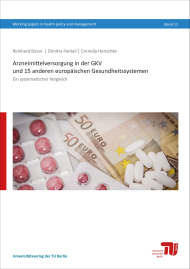Arzneimittelversorgung in der GKV und 15 anderen europäischen Gesundheitssystemen
Ein systematischer Vergleich

Format: 21,0 x 29,7 cm
Publishing year: 2015
Pharmaceutical care in the statutory health insurance system remains among the main topics in the health policy debate in Germany, not least regarding the benefit-oriented pricing and reimbursement amount negotiations introduced by the most recent changes in legislation. Prices for newly authorized pharmaceuticals are to depend on patient benefit. The Federal Joint Committee determines whether new patented pharmaceuticals have an additional benefit compared to existing alternatives and what it amounts to. Reimbursement amounts are agreed on by the manufacturers and the Federal Association of Sickness Funds (AMNOG negotiations), unless no additional benefit has been demonstrated and the pharmaceutical can be incorporated into a reference price group.
The objective of this systematic country comparison was to contextualize pharmaceutical care in the statutory health insurance system in Germany by illustrating its main characteristics and underlying regulatory mechanisms in relation to other European health systems. The investigation spans measures related to marketing authorization; pricing and price updates; post-marketing evaluations guiding coverage decisions (health technology assessment); patient cost-sharing; specific cost and quality control measures targeting individual stakeholder groups (industry, wholesalers/pharmacists, prescribers); generic substitution; and resulting price levels.
Including Germany, a sample of 16 European health systems was selected (Austria, Belgium, Denmark, England, Finland, France, Germany, Greece, Ireland, Italy, the Netherlands, Poland, Portugal, Scotland, Spain, and Sweden). Quantitative data from the OECD, country-specific regulatory documents as well as published and grey literature were combined to form an initial evidence base in the form of health system profiles, which were then sent to relevant experts for review and validation.
Compared to the other health systems in the sample, pharmaceutical care in the statutory health insurance system in Germany is characterized by a very short delay between marketing authorization of new pharmaceuticals and their statutory reimbursement (i.e. actual patient access), as well as high availability of such products. While in other health systems reimbursement restrictions based on indication or patient group are not uncommon, virtually all authorized products and all authorized indications per product are eligible for reimbursement in the German statutory system. This comparatively generous reimbursement, in conjunction with moderate copayments, is reflected in the public pharmaceutical expenditure per capita, which is among the highest in the sample. Total pharmaceutical expenditure is also relatively high, both per capita and as a share of GDP. Given that the share of generics in Germany is quite high, it is likely that above-average price levels and the utilization of new (and more expensive) pharmaceuticals contribute to this phenomenon.
Thus, enabling better access to innovative pharmaceuticals and lowering financial hurdles for patients do not seem to be the main challenges for the German pharmaceutical market. However, cost and quality aspects merit continued attention. To increase value for money, a more targeted utilization control could be considered, for example by differentiating reimbursement eligibility for newly authorized pharmaceuticals. Since benefit assessments by the Federal Joint Committee already consider evidence at subgroup level, the necessary information is already available and could be used to inform decisions on reimbursement eligibility in addition to pricing.



